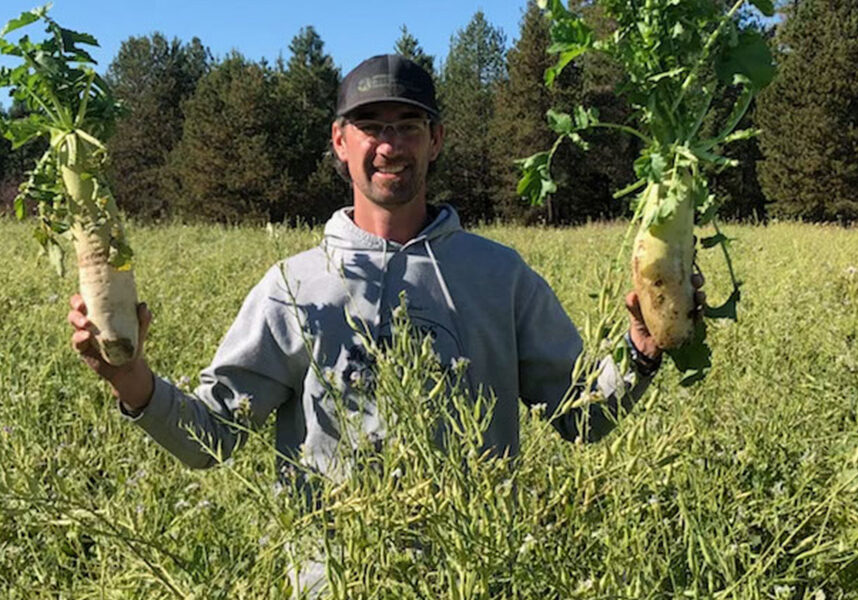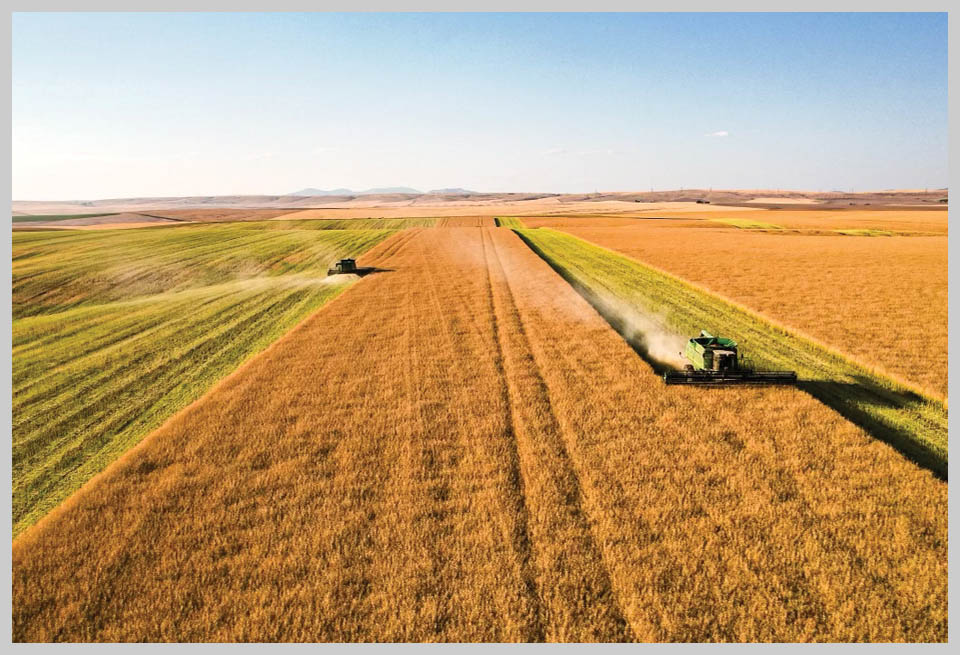Finding the right recipe Eastern Washington growers uncover some of the uncertainties of cover crops
2021November 2021
By Trista Crossley
Editor

In Eastern Washington, cover crops hold promise, but growers are still weeding out some issues.
Ryan Poe, a grower from Grant County and president of the Washington Association of Wheat Growers, ran into one of those issues in 2019 and 2020 when he planted a cover crop at the same time he direct seeded 25 acres of winter wheat. The idea was that the cover crop, rather than chemicals, would keep weeds in check. The cover crop would terminate during the winter leaving a wheat crop he could take to harvest. Unfortunately, Poe ended up with subpar stands of wheat that were ineligible for crop insurance as the Risk Management Agency deemed the experiment too…experimental. Despite considering the trial to be a failure from the crop side, Poe said some of the results were positive.
“I thought we were going to have a weedy big mess,” Poe said. “It was shocking to me. We didn’t get Russian thistles and other weeds that I would have expected.”
Poe thinks there might have been a green bridge issue as the wheat stand had some disease problems. His concern, aside from the fact that there are still some crop insurance issues to iron out, is that the traditional cover crop model isn’t going to work in the dryer regions of Eastern Washington that practice a summer fallow rotation.
“If we plant a cover crop in the spring and terminate it in late summer, we might end up using stored moisture that the winter wheat crop needs. At that point, I don’t think we’ll be getting any benefits out of a cover crop,” he explained, adding that he knows a lot of Eastern Washington growers who want cover crops to work.
‘When it dies, it dries’
That moisture concern is understood by Mike Nestor, a manager/agronomist-CCA at Ag Enterprise’s Wilbur, Wash., branch, who has worked with Poe and many other Eastern Washington wheat growers on cover crop experiments over the past seven or eight years.
“Everybody is scared of using the moisture in the ground and not having enough moisture for crop production. That’s the experiment, that’s the game,” he said. But in Nestor’s experience, that’s not really what’s happening. “We are seeing some good benefits. There’s lots of diversity to the soil profile. We are seeing the soil break some stuff down and hold moisture better than fallow.”
Nestor and the folks he’s working with on cover crops have come up with a saying, “When it dies, it dries.” The experiments he’s participated in have shown that when the cover crop is terminated, the soil loses moisture immediately. He believes that it’s the plants and their biology that is holding the moisture in the soil, and without plants, the biology goes dormant, and the moisture is lost. Even in a drought year like 2021, Nestor said he’s seeing some cover crop-planted fields holding moisture better than fallow fields.
 Why cover crops?
Why cover crops?
The reasons for using cover crops are as varied as the ways in which cover crops can be used. For some growers, it is part of a payment program or a way to save on crop insurance premiums. For some, it’s an alternate way to manage weeds and use less chemicals. For others, especially direct seeders, it’s a way to replace residue lost through a natural disaster, such as a fire. In some situations, cover crops can be grazed or swathed. Some growers will treat it as a green manure and turn it into the soil to decompose.
According to the Natural Resources Conservation Service’s (NRCS) Washington state office, over the past five years, NRCS has helped apply cover crops to 13,929 acres through the Environmental Quality Incentives Program and 12,559 acres through the Conservation Stewardship Program in Eastern Washington.
In an email, Tracy Hanger, NRCS’s Snake River Team district conservationist, said cover crops have been used to help treat resource concerns, including soil erosion, improved water quality, soil compaction and to break pest cycles. When implementing a cover crop, producers need to consider the best species and mix for the addressed resource concern, seed availability, seed costs, labor, timing with current crop rotations and previous crop herbicide residual.
“There’s no magic bullet for a cover crop mix as there are various purposes for them, and the management operations are just a little different. What is consistent though, is how the producers who continue to work with cover crops and modify their use continue to see benefits with each of those resource concerns they have been targeting,” Hanger said in the email.
Covering some of the issues
There are potential crop insurance conflicts with cover crops, such as a cover crop pushing a fallow-rotation grower into an annual cropping scenario or triggering RMA’s restriction on making a profit off a cover crop.
Nestor has also seen a yield problem in the cash crop when it is planted with a cover crop, and the cover crop is allowed to self-terminate. Although it removes three to four passes of chemical weed control, like Poe, he thinks there might be a green bridge problem.
“What we’ve learned now is that most of our seeds in the Pacific Northwest can’t tolerate that system. They aren’t bred for it. We have to remove the cash crop, keep it just as a cover crop and reseed into it later to break the green bridge,” he said. “We are learning and adjusting the system.”
There is also a slight yield drag as the cover crop can pull nutrients away from the cash crop. Nestor has learned that there has to be a certain amount of fertilizer in the soil with additional fertilizer added as a foliar application. He doesn’t think that is too surprising as today’s plants have been trained to be pushed by synthetic fertilizers.
“Nowhere in nature is she racing for yield. It’s all about survival. Plants have a different mentality. They want to survive and reproduce,” he said, adding that he expects that in most places, once the system is fine-tuned, any yield drag will be within 2 to 5 percent of normal yields. That yield drop will be compensated by savings in input costs. “I believe this is designed to allow producers to walk away from a chemical and synthetic diet. If they lower inputs but are running close to the same yields, they can make a system that will work.”
Nestor also sees cover crops as a potential tool in the fight against resistant weeds.
Finding the right recipe
Just outside of Spokane, Wash., Josh Riddle has been experimenting with cover crops in his no-till fields for about eight years. He heard about a farmer in North Dakota who has been able to cut his fertilizer use to zero through the use of cover crops.
“I was really interested in that,” Riddle said. “I’ve watched my pH drop and the organic matter stay kind of stagnate. The idea of no till, to plant a wheat crop, is you use a bunch of chemicals to keep grasses and weeds in check and put fertilizer down to deal with the residue. This doesn’t seem sustainable long term. I’m farming around people and houses, and it made me want to change things up.”
Riddle started out with turnips, radishes and sunflowers as a cover crop on some of his ground. He quickly learned not to seed his cover crop too early, as that first year, he ended up dealing with “turnips as big as cantaloupes and radishes as big as my forearm coming out of the ground like little torpedoes.” He had to figure out how to seed into a cover crop that was four feet tall. He’s found success by doing some high-speed tillage and shallow discing to knock the cover crop down.
“I’ve found that to not get the size issue, I can plant (the cover crop) as late as July 7,” he said. Riddle will “green seed” his winter wheat or other cash crop into the cover crop and let the frost terminate the cover crop. He said he’s tried to manually terminate the cover crop before seeding his cash crop, but has run into problems trying to seed through dry residue. “If it is green and growing, it slices like lettuce instead of tough straw.”
This spring, Riddle hopes to put cover crops on approximately 300 acres. So far, he hasn’t seen the cover crops stealing moisture from his cash crop. He has had to deal with a few more pests, but believes there’s a way to deal with them with minimal chemical usage. He cautions other growers, however, that there is no one silver bullet when it comes to finding the right cover crop system.
“Each field has its own recipe. You start putting recipes together and finding what recipe works best for your ground,” he said. “It’s a process, finding what works, what doesn’t work. Every year is different. My recommendation is to just try some things.”
One of Riddle’s biggest challenges is managing the chemicals he uses on his cash crop so the residues don’t hurt his cover crops. He’s also run into crop insurance problems when his nonlegume cover crop flipped him from a fallow rotation to a continuous cropping designation.
Riddle says he largely considers his cover cropping experiments successful and is seeing his soil come alive.
“Growing up, we didn’t see a lot of worms in the dirt. Now I dig up soil and find worms everywhere. Those are free fertilizer employees! Nothing is more satisfying than seeing things come back to life,” he said.
















